Analysis of Health and Social Care Policies for Teenage Cancer in UK
VerifiedAdded on 2023/06/18
|8
|1880
|251
Report
AI Summary
This report provides an overview of health and social care policies in the United Kingdom concerning teenage cancer, a condition affecting a small but significant portion of the young population. It highlights the NHS Cancer Services for Teenagers and Young Adults policy, which divides care plans into age groups and emphasizes treatment at specialized centers. The report also discusses the role of Clinical Commissioning Groups (CCGs) established by the Health and Social Care Act 2012, focusing on policies like Dexrazoxane use for preventing cardiotoxicity and Plerixafor for stem cell mobilization. These policies aim to improve patient outcomes through safe, evidence-based treatment and effective care planning. The report concludes that these policies, while essential, must address genetic, environmental, and lifestyle factors contributing to teenage cancer, ensuring comprehensive care and support for service users.
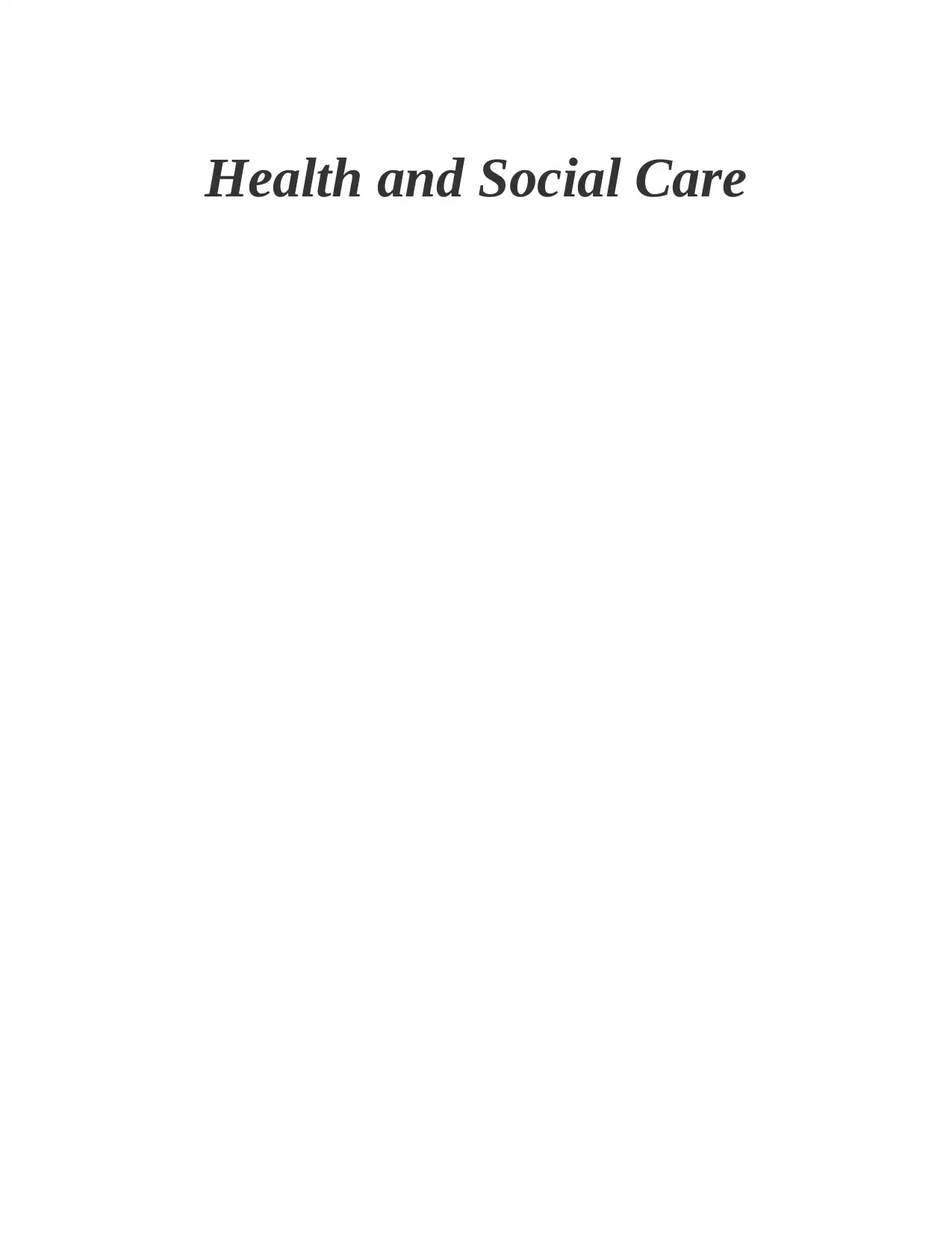
Health and Social Care
Paraphrase This Document
Need a fresh take? Get an instant paraphrase of this document with our AI Paraphraser
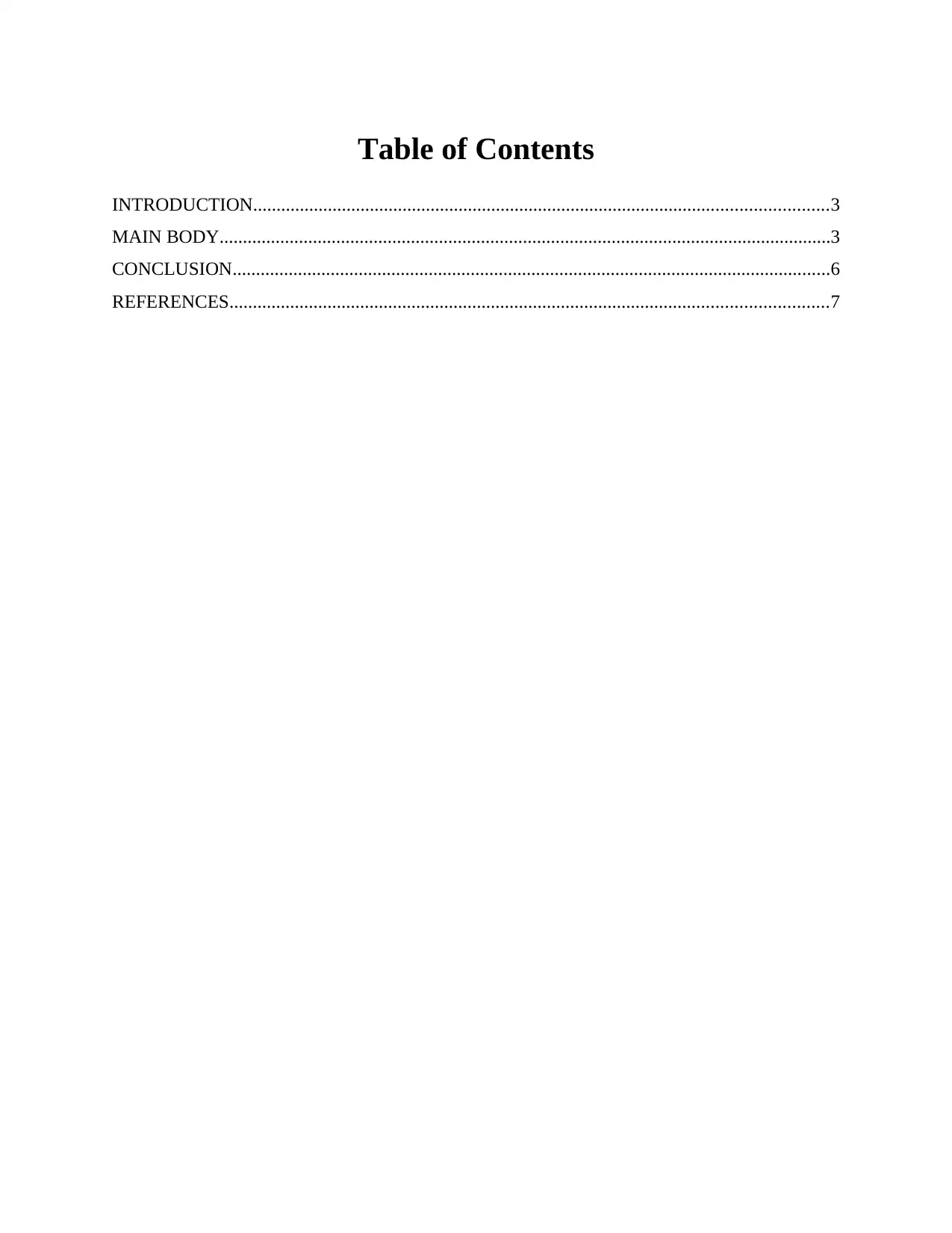
Table of Contents
INTRODUCTION...........................................................................................................................3
MAIN BODY...................................................................................................................................3
CONCLUSION................................................................................................................................6
REFERENCES................................................................................................................................7
INTRODUCTION...........................................................................................................................3
MAIN BODY...................................................................................................................................3
CONCLUSION................................................................................................................................6
REFERENCES................................................................................................................................7
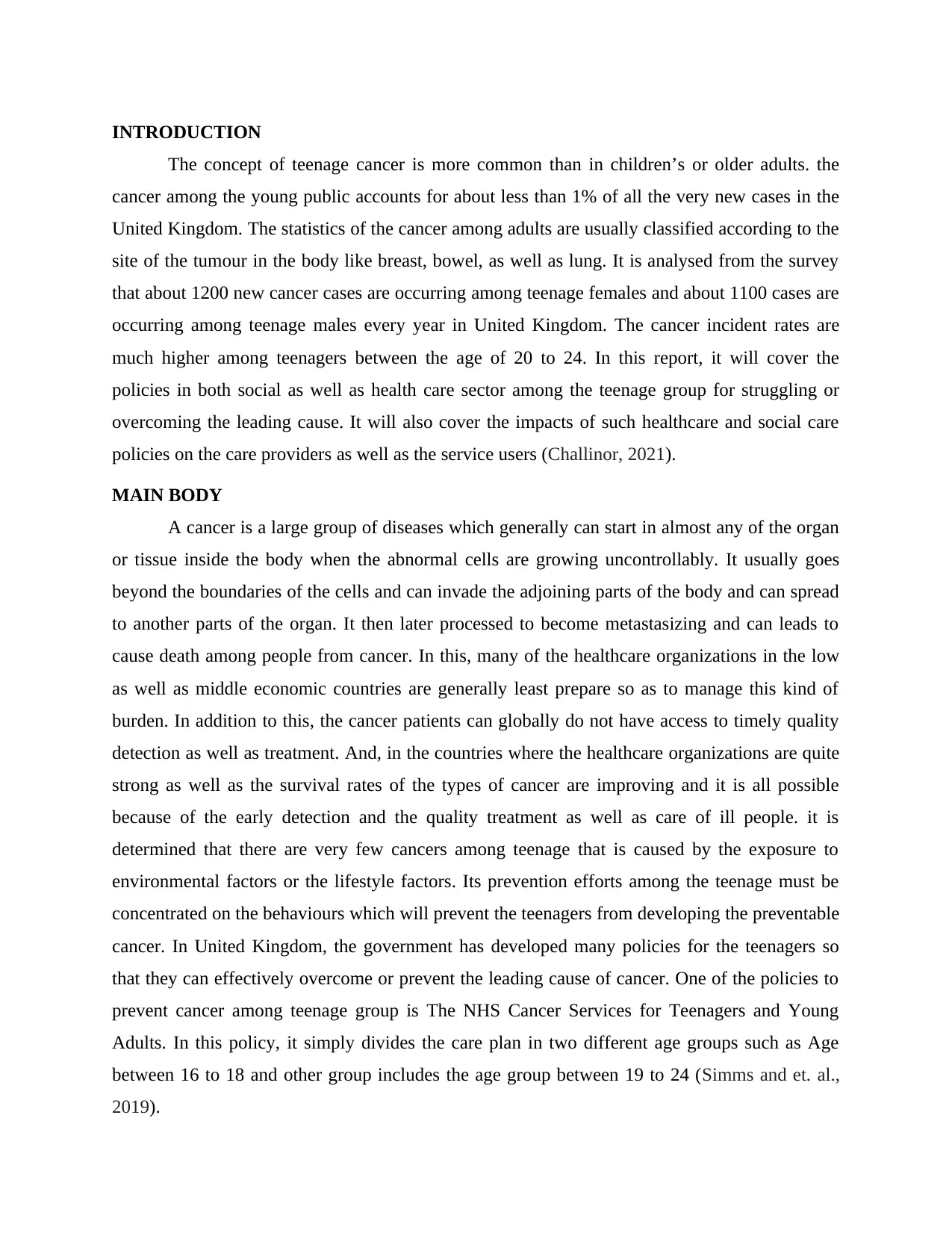
INTRODUCTION
The concept of teenage cancer is more common than in children’s or older adults. the
cancer among the young public accounts for about less than 1% of all the very new cases in the
United Kingdom. The statistics of the cancer among adults are usually classified according to the
site of the tumour in the body like breast, bowel, as well as lung. It is analysed from the survey
that about 1200 new cancer cases are occurring among teenage females and about 1100 cases are
occurring among teenage males every year in United Kingdom. The cancer incident rates are
much higher among teenagers between the age of 20 to 24. In this report, it will cover the
policies in both social as well as health care sector among the teenage group for struggling or
overcoming the leading cause. It will also cover the impacts of such healthcare and social care
policies on the care providers as well as the service users (Challinor, 2021).
MAIN BODY
A cancer is a large group of diseases which generally can start in almost any of the organ
or tissue inside the body when the abnormal cells are growing uncontrollably. It usually goes
beyond the boundaries of the cells and can invade the adjoining parts of the body and can spread
to another parts of the organ. It then later processed to become metastasizing and can leads to
cause death among people from cancer. In this, many of the healthcare organizations in the low
as well as middle economic countries are generally least prepare so as to manage this kind of
burden. In addition to this, the cancer patients can globally do not have access to timely quality
detection as well as treatment. And, in the countries where the healthcare organizations are quite
strong as well as the survival rates of the types of cancer are improving and it is all possible
because of the early detection and the quality treatment as well as care of ill people. it is
determined that there are very few cancers among teenage that is caused by the exposure to
environmental factors or the lifestyle factors. Its prevention efforts among the teenage must be
concentrated on the behaviours which will prevent the teenagers from developing the preventable
cancer. In United Kingdom, the government has developed many policies for the teenagers so
that they can effectively overcome or prevent the leading cause of cancer. One of the policies to
prevent cancer among teenage group is The NHS Cancer Services for Teenagers and Young
Adults. In this policy, it simply divides the care plan in two different age groups such as Age
between 16 to 18 and other group includes the age group between 19 to 24 (Simms and et. al.,
2019).
The concept of teenage cancer is more common than in children’s or older adults. the
cancer among the young public accounts for about less than 1% of all the very new cases in the
United Kingdom. The statistics of the cancer among adults are usually classified according to the
site of the tumour in the body like breast, bowel, as well as lung. It is analysed from the survey
that about 1200 new cancer cases are occurring among teenage females and about 1100 cases are
occurring among teenage males every year in United Kingdom. The cancer incident rates are
much higher among teenagers between the age of 20 to 24. In this report, it will cover the
policies in both social as well as health care sector among the teenage group for struggling or
overcoming the leading cause. It will also cover the impacts of such healthcare and social care
policies on the care providers as well as the service users (Challinor, 2021).
MAIN BODY
A cancer is a large group of diseases which generally can start in almost any of the organ
or tissue inside the body when the abnormal cells are growing uncontrollably. It usually goes
beyond the boundaries of the cells and can invade the adjoining parts of the body and can spread
to another parts of the organ. It then later processed to become metastasizing and can leads to
cause death among people from cancer. In this, many of the healthcare organizations in the low
as well as middle economic countries are generally least prepare so as to manage this kind of
burden. In addition to this, the cancer patients can globally do not have access to timely quality
detection as well as treatment. And, in the countries where the healthcare organizations are quite
strong as well as the survival rates of the types of cancer are improving and it is all possible
because of the early detection and the quality treatment as well as care of ill people. it is
determined that there are very few cancers among teenage that is caused by the exposure to
environmental factors or the lifestyle factors. Its prevention efforts among the teenage must be
concentrated on the behaviours which will prevent the teenagers from developing the preventable
cancer. In United Kingdom, the government has developed many policies for the teenagers so
that they can effectively overcome or prevent the leading cause of cancer. One of the policies to
prevent cancer among teenage group is The NHS Cancer Services for Teenagers and Young
Adults. In this policy, it simply divides the care plan in two different age groups such as Age
between 16 to 18 and other group includes the age group between 19 to 24 (Simms and et. al.,
2019).
⊘ This is a preview!⊘
Do you want full access?
Subscribe today to unlock all pages.

Trusted by 1+ million students worldwide
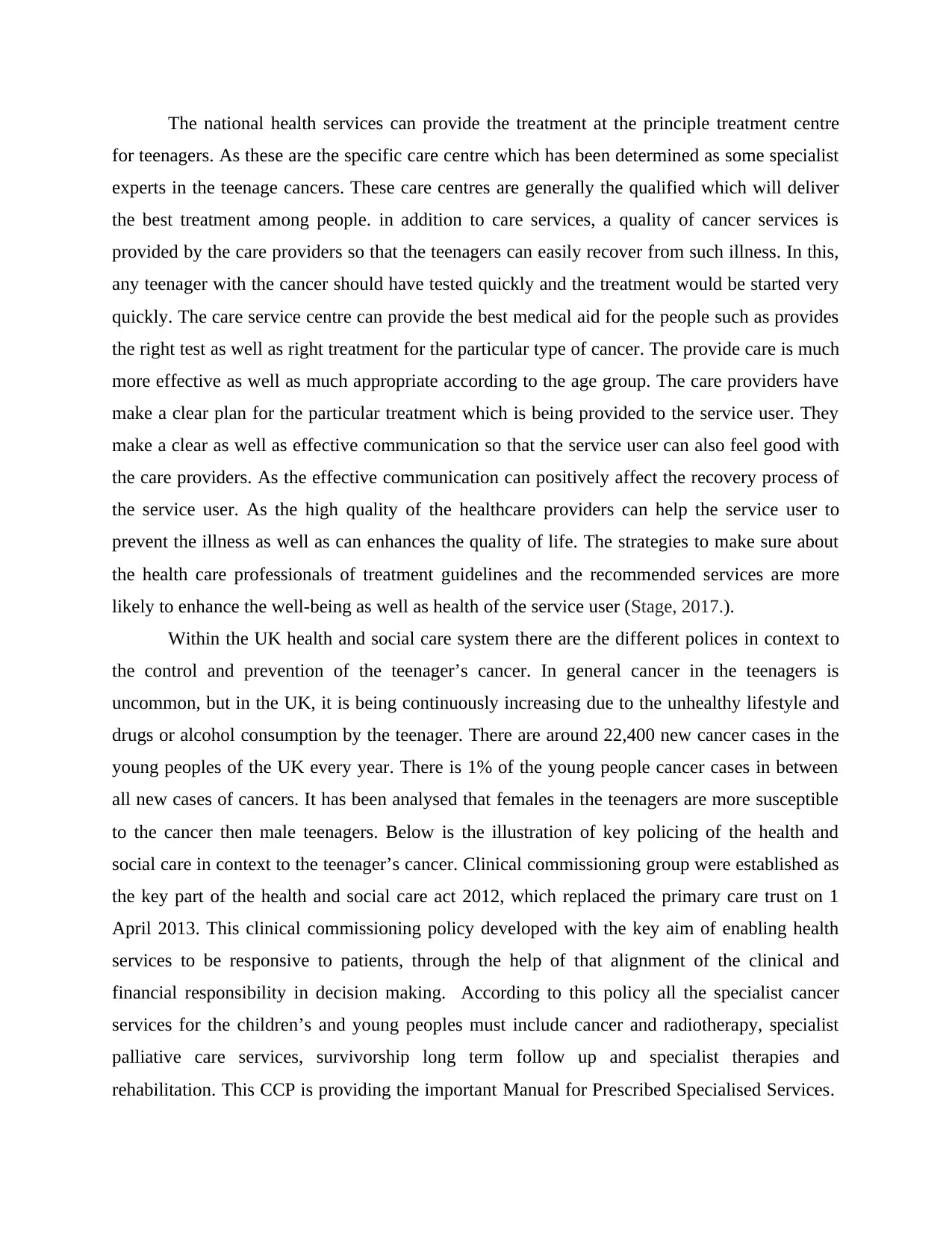
The national health services can provide the treatment at the principle treatment centre
for teenagers. As these are the specific care centre which has been determined as some specialist
experts in the teenage cancers. These care centres are generally the qualified which will deliver
the best treatment among people. in addition to care services, a quality of cancer services is
provided by the care providers so that the teenagers can easily recover from such illness. In this,
any teenager with the cancer should have tested quickly and the treatment would be started very
quickly. The care service centre can provide the best medical aid for the people such as provides
the right test as well as right treatment for the particular type of cancer. The provide care is much
more effective as well as much appropriate according to the age group. The care providers have
make a clear plan for the particular treatment which is being provided to the service user. They
make a clear as well as effective communication so that the service user can also feel good with
the care providers. As the effective communication can positively affect the recovery process of
the service user. As the high quality of the healthcare providers can help the service user to
prevent the illness as well as can enhances the quality of life. The strategies to make sure about
the health care professionals of treatment guidelines and the recommended services are more
likely to enhance the well-being as well as health of the service user (Stage, 2017.).
Within the UK health and social care system there are the different polices in context to
the control and prevention of the teenager’s cancer. In general cancer in the teenagers is
uncommon, but in the UK, it is being continuously increasing due to the unhealthy lifestyle and
drugs or alcohol consumption by the teenager. There are around 22,400 new cancer cases in the
young peoples of the UK every year. There is 1% of the young people cancer cases in between
all new cases of cancers. It has been analysed that females in the teenagers are more susceptible
to the cancer then male teenagers. Below is the illustration of key policing of the health and
social care in context to the teenager’s cancer. Clinical commissioning group were established as
the key part of the health and social care act 2012, which replaced the primary care trust on 1
April 2013. This clinical commissioning policy developed with the key aim of enabling health
services to be responsive to patients, through the help of that alignment of the clinical and
financial responsibility in decision making. According to this policy all the specialist cancer
services for the children’s and young peoples must include cancer and radiotherapy, specialist
palliative care services, survivorship long term follow up and specialist therapies and
rehabilitation. This CCP is providing the important Manual for Prescribed Specialised Services.
for teenagers. As these are the specific care centre which has been determined as some specialist
experts in the teenage cancers. These care centres are generally the qualified which will deliver
the best treatment among people. in addition to care services, a quality of cancer services is
provided by the care providers so that the teenagers can easily recover from such illness. In this,
any teenager with the cancer should have tested quickly and the treatment would be started very
quickly. The care service centre can provide the best medical aid for the people such as provides
the right test as well as right treatment for the particular type of cancer. The provide care is much
more effective as well as much appropriate according to the age group. The care providers have
make a clear plan for the particular treatment which is being provided to the service user. They
make a clear as well as effective communication so that the service user can also feel good with
the care providers. As the effective communication can positively affect the recovery process of
the service user. As the high quality of the healthcare providers can help the service user to
prevent the illness as well as can enhances the quality of life. The strategies to make sure about
the health care professionals of treatment guidelines and the recommended services are more
likely to enhance the well-being as well as health of the service user (Stage, 2017.).
Within the UK health and social care system there are the different polices in context to
the control and prevention of the teenager’s cancer. In general cancer in the teenagers is
uncommon, but in the UK, it is being continuously increasing due to the unhealthy lifestyle and
drugs or alcohol consumption by the teenager. There are around 22,400 new cancer cases in the
young peoples of the UK every year. There is 1% of the young people cancer cases in between
all new cases of cancers. It has been analysed that females in the teenagers are more susceptible
to the cancer then male teenagers. Below is the illustration of key policing of the health and
social care in context to the teenager’s cancer. Clinical commissioning group were established as
the key part of the health and social care act 2012, which replaced the primary care trust on 1
April 2013. This clinical commissioning policy developed with the key aim of enabling health
services to be responsive to patients, through the help of that alignment of the clinical and
financial responsibility in decision making. According to this policy all the specialist cancer
services for the children’s and young peoples must include cancer and radiotherapy, specialist
palliative care services, survivorship long term follow up and specialist therapies and
rehabilitation. This CCP is providing the important Manual for Prescribed Specialised Services.
Paraphrase This Document
Need a fresh take? Get an instant paraphrase of this document with our AI Paraphraser
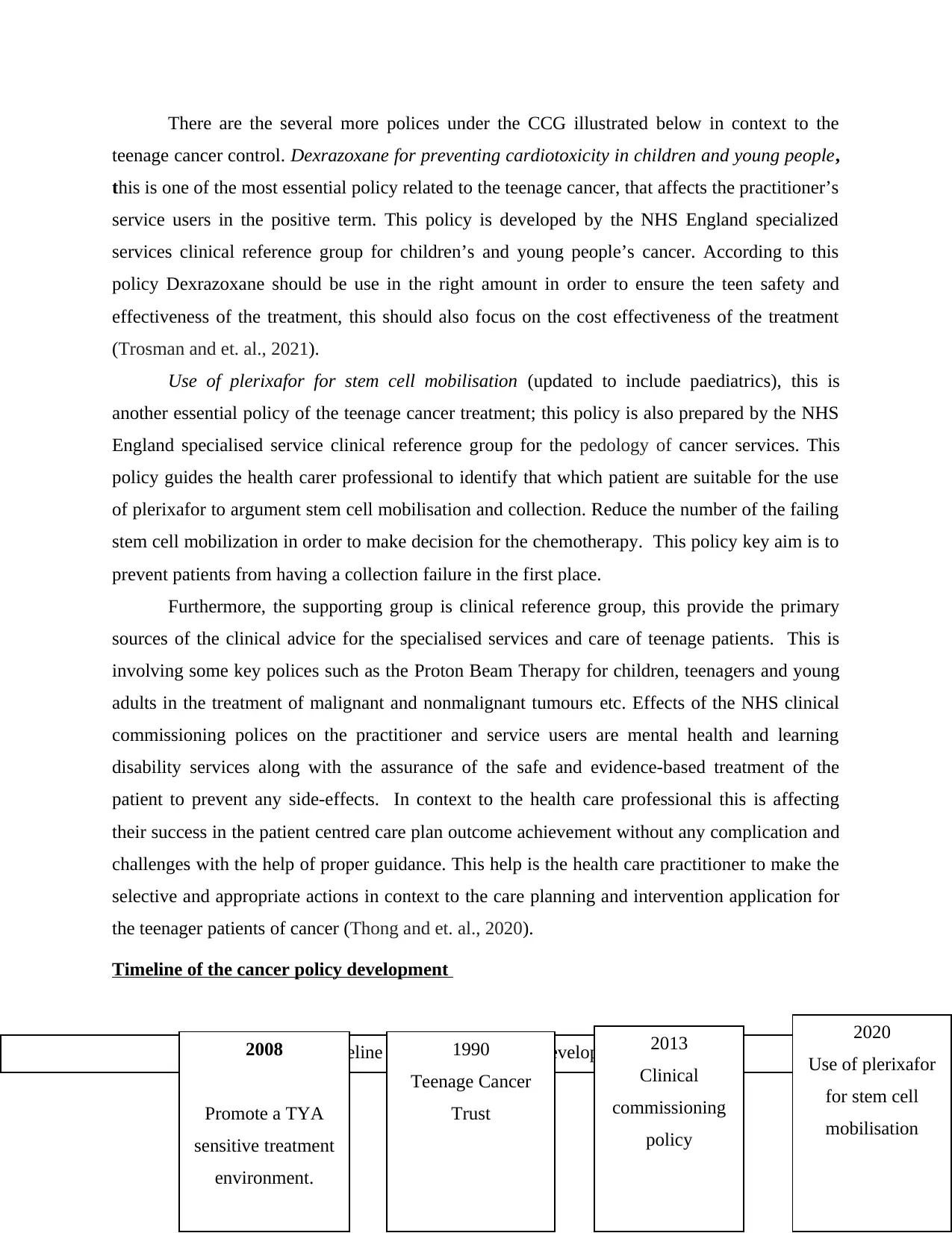
There are the several more polices under the CCG illustrated below in context to the
teenage cancer control. Dexrazoxane for preventing cardiotoxicity in children and young people,
this is one of the most essential policy related to the teenage cancer, that affects the practitioner’s
service users in the positive term. This policy is developed by the NHS England specialized
services clinical reference group for children’s and young people’s cancer. According to this
policy Dexrazoxane should be use in the right amount in order to ensure the teen safety and
effectiveness of the treatment, this should also focus on the cost effectiveness of the treatment
(Trosman and et. al., 2021).
Use of plerixafor for stem cell mobilisation (updated to include paediatrics), this is
another essential policy of the teenage cancer treatment; this policy is also prepared by the NHS
England specialised service clinical reference group for the pedology of cancer services. This
policy guides the health carer professional to identify that which patient are suitable for the use
of plerixafor to argument stem cell mobilisation and collection. Reduce the number of the failing
stem cell mobilization in order to make decision for the chemotherapy. This policy key aim is to
prevent patients from having a collection failure in the first place.
Furthermore, the supporting group is clinical reference group, this provide the primary
sources of the clinical advice for the specialised services and care of teenage patients. This is
involving some key polices such as the Proton Beam Therapy for children, teenagers and young
adults in the treatment of malignant and nonmalignant tumours etc. Effects of the NHS clinical
commissioning polices on the practitioner and service users are mental health and learning
disability services along with the assurance of the safe and evidence-based treatment of the
patient to prevent any side-effects. In context to the health care professional this is affecting
their success in the patient centred care plan outcome achievement without any complication and
challenges with the help of proper guidance. This help is the health care practitioner to make the
selective and appropriate actions in context to the care planning and intervention application for
the teenager patients of cancer (Thong and et. al., 2020).
Timeline of the cancer policy development
Timeline of the cancer policy development2008
Promote a TYA
sensitive treatment
environment.
1990
Teenage Cancer
Trust
2013
Clinical
commissioning
policy
2020
Dexrazoxane for
preventing
cardiotoxicity in
children and
young people
2020
Use of plerixafor
for stem cell
mobilisation
teenage cancer control. Dexrazoxane for preventing cardiotoxicity in children and young people,
this is one of the most essential policy related to the teenage cancer, that affects the practitioner’s
service users in the positive term. This policy is developed by the NHS England specialized
services clinical reference group for children’s and young people’s cancer. According to this
policy Dexrazoxane should be use in the right amount in order to ensure the teen safety and
effectiveness of the treatment, this should also focus on the cost effectiveness of the treatment
(Trosman and et. al., 2021).
Use of plerixafor for stem cell mobilisation (updated to include paediatrics), this is
another essential policy of the teenage cancer treatment; this policy is also prepared by the NHS
England specialised service clinical reference group for the pedology of cancer services. This
policy guides the health carer professional to identify that which patient are suitable for the use
of plerixafor to argument stem cell mobilisation and collection. Reduce the number of the failing
stem cell mobilization in order to make decision for the chemotherapy. This policy key aim is to
prevent patients from having a collection failure in the first place.
Furthermore, the supporting group is clinical reference group, this provide the primary
sources of the clinical advice for the specialised services and care of teenage patients. This is
involving some key polices such as the Proton Beam Therapy for children, teenagers and young
adults in the treatment of malignant and nonmalignant tumours etc. Effects of the NHS clinical
commissioning polices on the practitioner and service users are mental health and learning
disability services along with the assurance of the safe and evidence-based treatment of the
patient to prevent any side-effects. In context to the health care professional this is affecting
their success in the patient centred care plan outcome achievement without any complication and
challenges with the help of proper guidance. This help is the health care practitioner to make the
selective and appropriate actions in context to the care planning and intervention application for
the teenager patients of cancer (Thong and et. al., 2020).
Timeline of the cancer policy development
Timeline of the cancer policy development2008
Promote a TYA
sensitive treatment
environment.
1990
Teenage Cancer
Trust
2013
Clinical
commissioning
policy
2020
Dexrazoxane for
preventing
cardiotoxicity in
children and
young people
2020
Use of plerixafor
for stem cell
mobilisation

⊘ This is a preview!⊘
Do you want full access?
Subscribe today to unlock all pages.

Trusted by 1+ million students worldwide
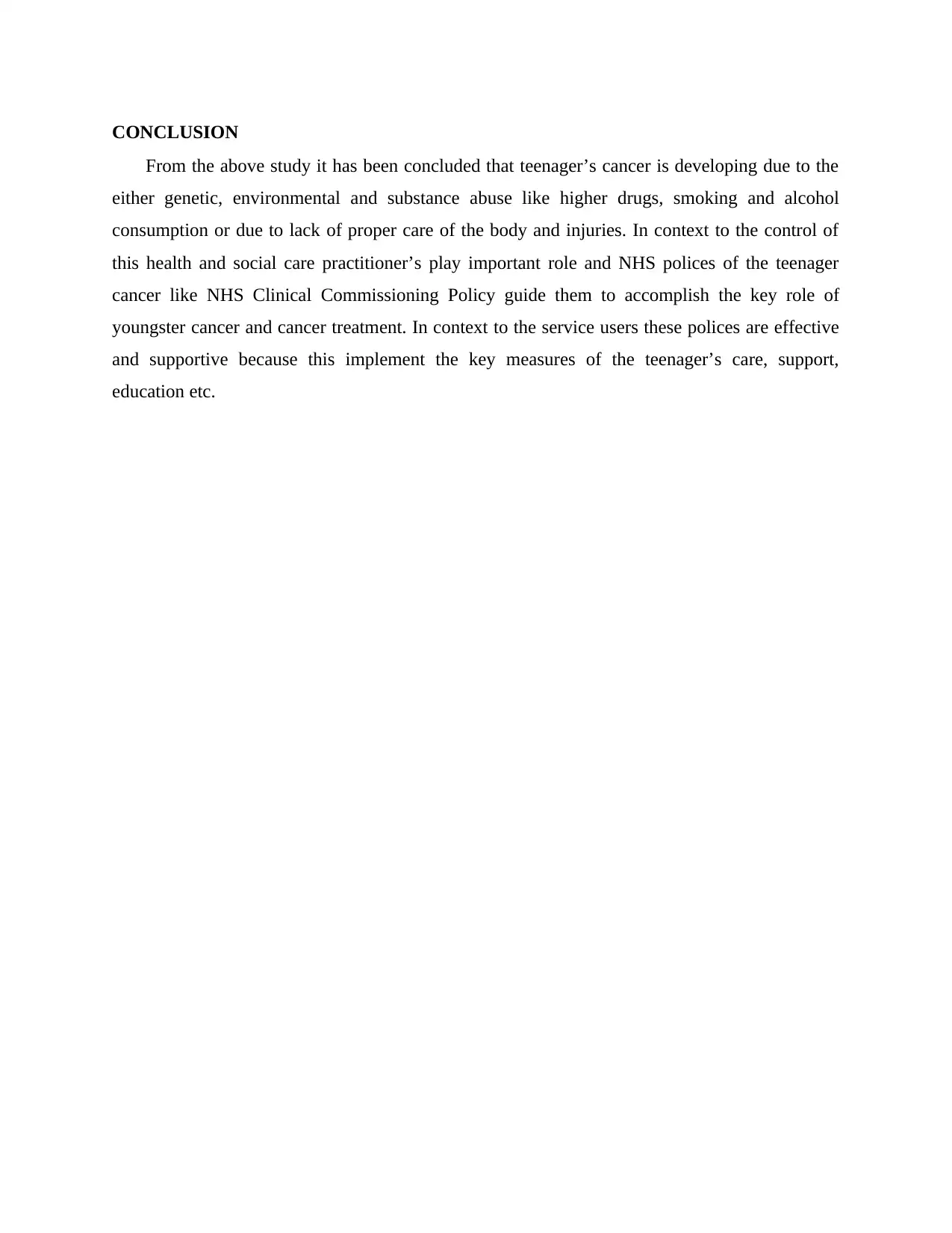
CONCLUSION
From the above study it has been concluded that teenager’s cancer is developing due to the
either genetic, environmental and substance abuse like higher drugs, smoking and alcohol
consumption or due to lack of proper care of the body and injuries. In context to the control of
this health and social care practitioner’s play important role and NHS polices of the teenager
cancer like NHS Clinical Commissioning Policy guide them to accomplish the key role of
youngster cancer and cancer treatment. In context to the service users these polices are effective
and supportive because this implement the key measures of the teenager’s care, support,
education etc.
From the above study it has been concluded that teenager’s cancer is developing due to the
either genetic, environmental and substance abuse like higher drugs, smoking and alcohol
consumption or due to lack of proper care of the body and injuries. In context to the control of
this health and social care practitioner’s play important role and NHS polices of the teenager
cancer like NHS Clinical Commissioning Policy guide them to accomplish the key role of
youngster cancer and cancer treatment. In context to the service users these polices are effective
and supportive because this implement the key measures of the teenager’s care, support,
education etc.
Paraphrase This Document
Need a fresh take? Get an instant paraphrase of this document with our AI Paraphraser
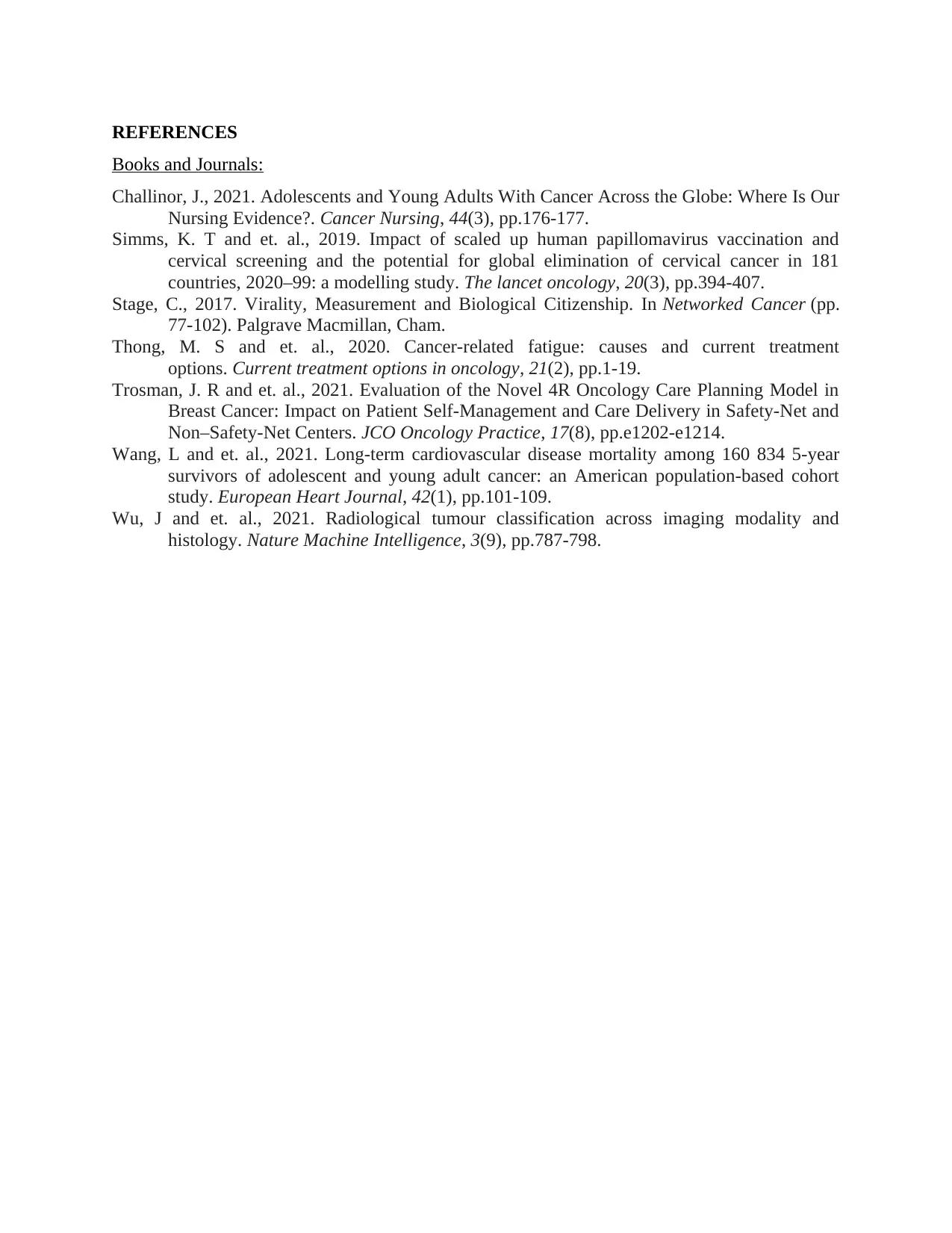
REFERENCES
Books and Journals:
Challinor, J., 2021. Adolescents and Young Adults With Cancer Across the Globe: Where Is Our
Nursing Evidence?. Cancer Nursing, 44(3), pp.176-177.
Simms, K. T and et. al., 2019. Impact of scaled up human papillomavirus vaccination and
cervical screening and the potential for global elimination of cervical cancer in 181
countries, 2020–99: a modelling study. The lancet oncology, 20(3), pp.394-407.
Stage, C., 2017. Virality, Measurement and Biological Citizenship. In Networked Cancer (pp.
77-102). Palgrave Macmillan, Cham.
Thong, M. S and et. al., 2020. Cancer-related fatigue: causes and current treatment
options. Current treatment options in oncology, 21(2), pp.1-19.
Trosman, J. R and et. al., 2021. Evaluation of the Novel 4R Oncology Care Planning Model in
Breast Cancer: Impact on Patient Self-Management and Care Delivery in Safety-Net and
Non–Safety-Net Centers. JCO Oncology Practice, 17(8), pp.e1202-e1214.
Wang, L and et. al., 2021. Long-term cardiovascular disease mortality among 160 834 5-year
survivors of adolescent and young adult cancer: an American population-based cohort
study. European Heart Journal, 42(1), pp.101-109.
Wu, J and et. al., 2021. Radiological tumour classification across imaging modality and
histology. Nature Machine Intelligence, 3(9), pp.787-798.
Books and Journals:
Challinor, J., 2021. Adolescents and Young Adults With Cancer Across the Globe: Where Is Our
Nursing Evidence?. Cancer Nursing, 44(3), pp.176-177.
Simms, K. T and et. al., 2019. Impact of scaled up human papillomavirus vaccination and
cervical screening and the potential for global elimination of cervical cancer in 181
countries, 2020–99: a modelling study. The lancet oncology, 20(3), pp.394-407.
Stage, C., 2017. Virality, Measurement and Biological Citizenship. In Networked Cancer (pp.
77-102). Palgrave Macmillan, Cham.
Thong, M. S and et. al., 2020. Cancer-related fatigue: causes and current treatment
options. Current treatment options in oncology, 21(2), pp.1-19.
Trosman, J. R and et. al., 2021. Evaluation of the Novel 4R Oncology Care Planning Model in
Breast Cancer: Impact on Patient Self-Management and Care Delivery in Safety-Net and
Non–Safety-Net Centers. JCO Oncology Practice, 17(8), pp.e1202-e1214.
Wang, L and et. al., 2021. Long-term cardiovascular disease mortality among 160 834 5-year
survivors of adolescent and young adult cancer: an American population-based cohort
study. European Heart Journal, 42(1), pp.101-109.
Wu, J and et. al., 2021. Radiological tumour classification across imaging modality and
histology. Nature Machine Intelligence, 3(9), pp.787-798.
1 out of 8
Related Documents
Your All-in-One AI-Powered Toolkit for Academic Success.
+13062052269
info@desklib.com
Available 24*7 on WhatsApp / Email
![[object Object]](/_next/static/media/star-bottom.7253800d.svg)
Unlock your academic potential
Copyright © 2020–2025 A2Z Services. All Rights Reserved. Developed and managed by ZUCOL.





